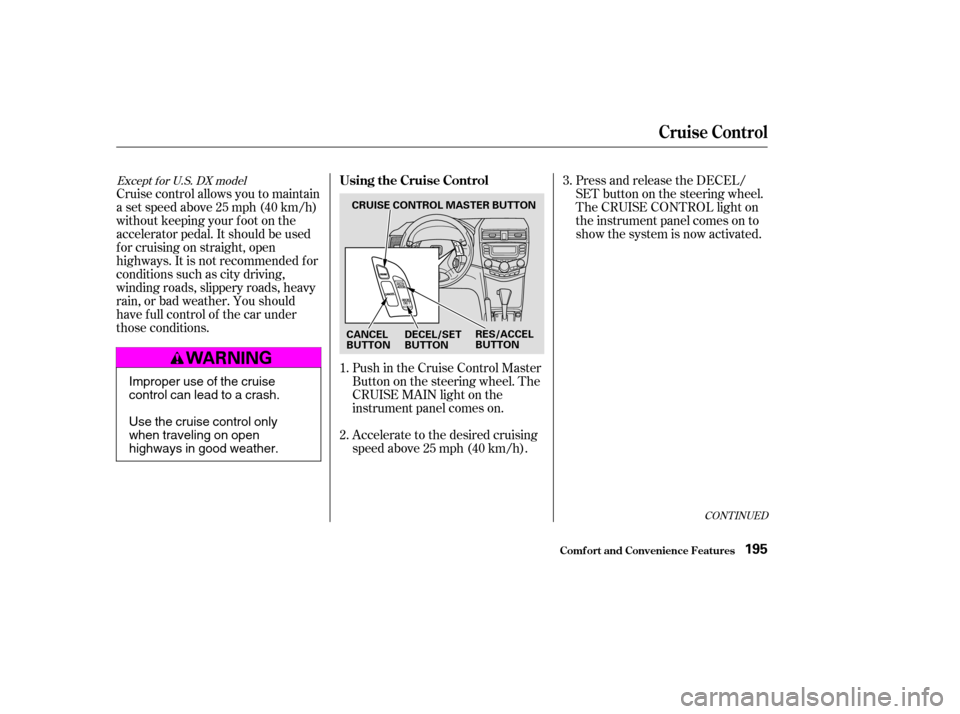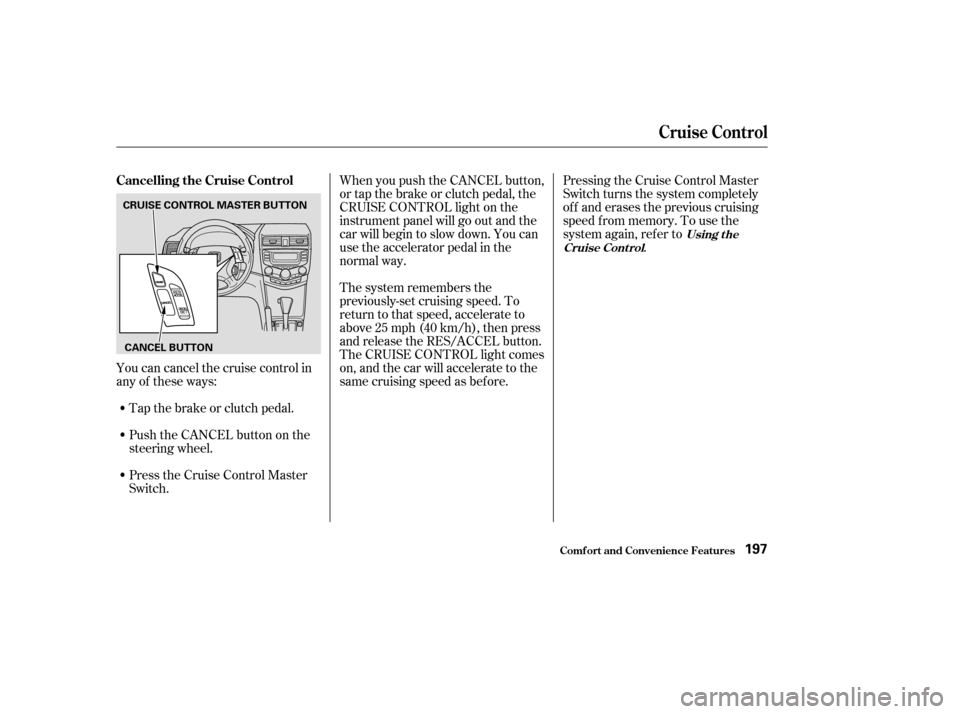Page 2 of 380
�Î
�Î
Only on cars equipped with Navigation System. Ref er to the Navigation System Owner’s Manual.
Your Car at a Glance
3
WINDSHIELD
WIPERS/WASHERS
HORN
INSTRUMENT PANEL
BRIGHTNESS
REAR WINDOW
DEFOGGER
MOONROOF
SWITCH
TRACTION CONTROL SYSTEM(P. 69)
(P. 73) (P. 72)
HAZARD
WARNING LIGHTS
CRUISE CONTROLS
: VOICE CONTROL
SWITCHES
(P. 100)
TILT/TELESCOPIC
ADJUSTMENT(P. 70, 71/72)
(P. 232) (P. 195)
(P. 72, 112, 125, 131)
HEADLIGHTS/
TURN SIGNALS
(P. 68/70)
REMOTE AUDIO
CONTROLS
(P. 192)
�����—�����—�����y���
�����������y���
�(�����������y���������y
Page 54 of 380
The U.S. instrument panel is shown. Dif f erences f or the Canadian models are noted in thetext.
Indicator L ights
Inst rument s and Cont rols57
CRUISE CONTROL INDICATOR
LOW FUEL INDICATOR LIGHT ON INDICATOR
SEAT BELT REMINDER LIGHT MAINTENANCE REQUIRED
INDICATOR
HIGH BEAM INDICATOR
MALFUNCTION
INDICATOR LAMP TRACTION CONTROL SYSTEM
INDICATOR
CRUISE MAIN INDICATOR ANTI-LOCK BRAKE SYSTEM
INDICATOR
PARKING BRAKE AND BRAKE
SYSTEM INDICATOR TCS ACTIVATION INDICATOR
LOW OIL PRESSURE
INDICATOR (P.58)
CHARGING SYSTEM
INDICATOR (P.62)
(P.62)
DOOR MONITOR
SECURITY SYSTEM INDICATOR SUPPLEMENTAL
RESTRAINT SYSTEM
INDICATOR
(P.58)
(P.59)
(P.59)
(P.62)
(P.61)
(P.61) (P.59)
(P.65)
(P.60)
(P.58)
(P.61)
(P.58)
(P.58) (P.60)
IMMOBILIZER SYSTEM INDICATOR (P.62)
(P.59)
SIDE AIRBAG CUTOFF
INDICATOR
�����—�����—�����y�
�������������y���
�(�����������y���������y
Page 59 of 380

This indicator comes on f or a f ew
seconds when you turn the ignition
switch ON (II). It will then go of f if
you have inserted a properly-coded
ignition key. If it is not a properly-
coded key, the indicator will blink
and the engine will not start (see
page ).
This indicator also blinks several
times when you turn the ignition
switch f rom ON (II) to ACCESSORY
(I) or LOCK (0).
This light comes on when the
washer f luid level is low. Add washer
f luid when you see this light come on
(see page ).
This indicator lights when you turn
the ignition switch to ON (II) with
the headlight switch of f and the
parking brake set. It should go of f if
youturnontheheadlightsorrelease
the parking brake. If it comes on at
any other time, it means there is a
problem with the DRL. There may
also be a problem with the high
beam headlights.
This light comes on with the high
beam headlights. See page for
inf ormation on the headlight
controls.
On Canadian models, this indicator
comes on with reduced brightness
when the Daytime Running Lights
(DRL) are on (see page ).
This lights when you set the cruise
control. See page f or inf ormation
on operating the cruise control.
This indicator comes on when you
turn on the Cruise Control Master
Button. (see page .)
76
68
69 195
195
279
Canadian models only
Only on models equipped with Cruise
Control System
Canadian models only
Only on models equipped with Cruise
Control System
Immobilizer System
Indicator
Washer Level Indicator
‘‘Daytime Running
Lights’’ Indicator
High Beam Indicator
Cruise Main Indicator
Cruise Control Indicator
Indicator L ights
Inst rument s and Cont rols62
�����—�����—�����y���
�����������y���
�(�����������y���������y
Page 64 of 380
�Î
�Î
Thetwoleversonthesteering
column contain controls f or driving
f eatures you use most of ten. The lef t
lever controls the turn signals,
headlights, and high beams. The
right lever controls the windshield
washers and wipers.To use the horn, press the pad
around the ‘‘H’’ logo.
The controls under the lef t air vent
are f or the moonroof and the
Traction Control System.
The steering wheel adjustment lever
on the underside of the steering
column allows you to tilt and
telescope the steering wheel.
Inst rument s and Cont rols
Controls Near the Steering Wheel
67
INSTRUMENT PANEL
BRIGHTNESS
WINDSHIELD
WIPERS/WASHERS
HAZARD
WARNING
LIGHTS
REAR WINDOW
DEFOGGER
CRUISE
CONTROLS
TRACTION
CONTROL
SYSTEM
MOONROOF
SWITCH HEADLIGHTS/
TURN SIGNALS
(P. 69)
(P. 72)
(P. 73)
(P. 68/70)
(P. 100) (P. 232) (P. 70, 71/72)
(P. 195)
TILT/TELESCOPIC
ADJUSTMENT (P. 72, 112,
125, 131)
HORN
�����—�����—�����y�
�������������y���
�(�����������y���������y
Page 191 of 380

Accelerate to the desired cruising
speedabove25mph(40km/h).
Push in the Cruise Control Master
Buttononthesteeringwheel.The
CRUISE MAIN light on the
instrument panel comes on. Press and release the DECEL/
SET button on the steering wheel.
The CRUISE CONTROL light on
the instrument panel comes on to
show the system is now activated.
Cruise control allows you to maintain
asetspeedabove25mph(40km/h)
without keeping your f oot on the
accelerator pedal. It should be used
f or cruising on straight, open
highways. It is not recommended f or
conditions such as city driving,
winding roads, slippery roads, heavy
rain, or bad weather. You should
have f ull control of the car under
those conditions.
1. 2.3.
CONT INUED
Except f or U.S. DX modelUsing the Cruise Control
Cruise Control
Comf ort and Convenience Feat ures195
CRUISE CONTROL MASTER BUTTON
CANCEL
BUTTON RES/ACCEL
BUTTON
DECEL/SET
BUTTON
Improper use of the cruise
control can lead to a crash.
Use the cruise control only
when traveling on open
highways in good weather.
�����—�����—�����y������
��������y���
�(�����������y���
�����y
Page 192 of 380

Resting your f oot on the brake or
clutch pedal will cause the cruise
control to cancel.
Even with the cruise control turned
on, you can still use the accelerator
pedal to speed up f or passing. Af ter
completing the pass, take your foot
of f the accelerator pedal. The car
will return to the set cruising speed.
You can decrease the set cruising
speed in any of these ways:
You can increase the set cruising
speed in any of these ways:
When climbing a steep hill, the
automatic transmission may
downshif t to hold the set speed.
Thecruisecontrolmaynotholdthe
set speed when you are going up and
down hills. If your speed increases
going down a hill, use the brakes to
slow down to the desired speed. This
will cancel the cruise control. To
resume the set speed, press the
RES/ACCEL button. The CRUISE
CONTROL light on the instrument
panel comes on.
Press and hold the RES/ACCEL
button. The car will accelerate.
When you reach the desired
cruising speed, release the button. Push on the accelerator pedal. Ac-
celerate to the desired cruising
speed and press the DECEL/SET
button.
To increase your speed in very
small amounts, tap the RES/
ACCEL button repeatedly. Each
time you do this, your car will
speed up about 1 mph (1.6 km/h).
Press and hold the DECEL/SET
button. The car will decelerate.
Release the button when you
reach the desired speed.
To slow down in very small
amounts, tap the DECEL/SET
button repeatedly. Each time you
do this, your car will slow down
about 1 mph (1.6 km/h).Tap the brake or clutch pedal
lightly with your f oot. The
CRUISE CONTROL light on the
instrument panel will go out.
When the car slows to the desired
speed, press the DECEL/SET
button. The car will then maintain
the desired speed.
Changing the Set Speed
Cruise Control
Comf ort and Convenience Feat ures196
�����—�����—�����y������
��������y���
�(�����������y���
�����y
Page 193 of 380

Pressing the Cruise Control Master
Switch turns the system completely
of f and erases the previous cruising
speed f rom memory. To use the
system again, ref er to.
Press the Cruise Control Master
Switch.
Push the CANCEL button on the
steering wheel.
Tap the brake or clutch pedal.
Youcancancelthecruisecontrolin
any of these ways: When you push the CANCEL button,
or tap the brake or clutch pedal, the
CRUISE CONTROL light on the
instrument panel will go out and the
car will begin to slow down. You can
use the accelerator pedal in the
normal way.
The system remembers the
previously-set cruising speed. To
return to that speed, accelerate to
above25mph(40km/h),thenpress
and release the RES/ACCEL button.
The CRUISE CONTROL light comes
on, and the car will accelerate to the
same cruising speed as bef ore.
Using t he
Cruise Cont rol
Cancelling the Cruise Control
Cruise Control
Comf ort and Convenience Feat ures197
CANCEL BUTTON
CRUISE CONTROL MASTER BUTTON
�����—�����—�����y���������������y���
�(�����������y���������y
Page 206 of 380

A cold engine uses more f uel than a
warm engine. It is not necessary to
‘‘warm-up’’ a cold engine by letting it
idle f or a long time. You can drive
away in about a minute, no matter
how cold it is outside. The engine
will warm up f aster, and you get
better f uel economy. To cut down on
the number of ‘‘cold starts,’’ try to
combine several short trips into one.
You can improve f uel economy by
driving moderately. Rapid acceler-
ation, abrupt cornering, and hard
braking use more f uel.
Always drive in the highest gear that
allows the engine to run and acceler-
ate smoothly.
The air conditioning puts an extra
load on the engine which makes it
usemorefuel.Turnoff theA/Cto
cut down on air conditioning use.
Use the f low-through ventilation
when the outside air temperature is
moderate.
The condition of your car and your
driving habits are the two most
important things that affect the fuel
mileage you get.
Always maintain your car according
to the maintenance schedule. This
will keep it in top operating condition.
Depending on traf f ic conditions, try
to maintain a constant speed. Every
time you slow down and speed up,
your car uses extra f uel. Use the
cruise control, when appropriate, to
increase f uel economy.
An important part of that mainte-
nance is the
(see page ). For
example, an underinf lated tire
causes more ‘‘rolling resistance,’’
which uses f uel. It also wears out
f aster, so check the tire pressure at
least monthly.
In winter, the build-up of snow on
your car’s underside adds weight and
rolling resistance. Frequent cleaning
helps your f uel mileage and reduces
thechanceof corrosion. 265 Driving Habits
Owner Maintenance
Checks
Car Condition
Fuel Economy
Bef ore Driving211
�����—�����—�����y���������������y���
�(�����������y�����
���y